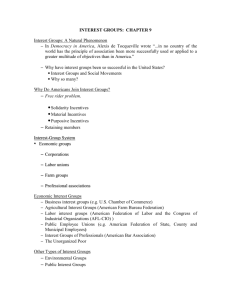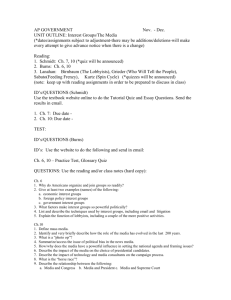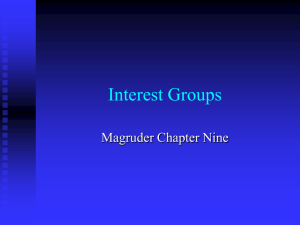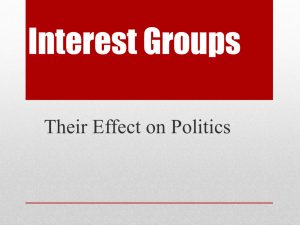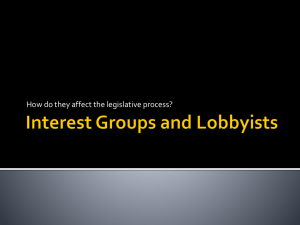Interest Groups
advertisement
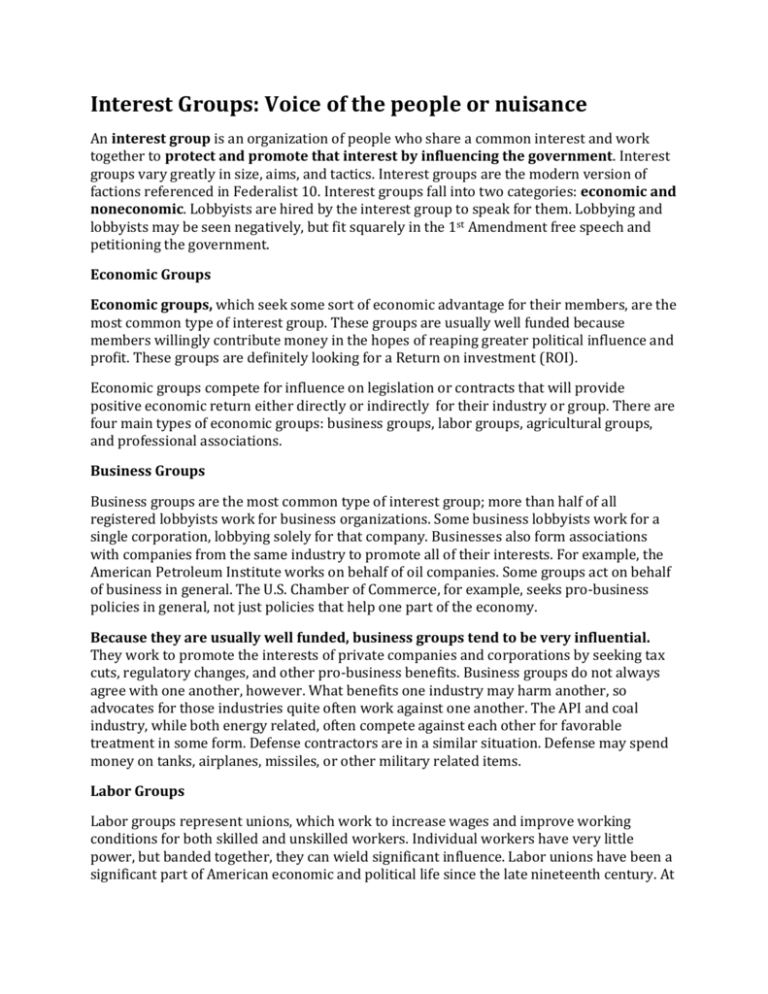
Interest Groups: Voice of the people or nuisance An interest group is an organization of people who share a common interest and work together to protect and promote that interest by influencing the government. Interest groups vary greatly in size, aims, and tactics. Interest groups are the modern version of factions referenced in Federalist 10. Interest groups fall into two categories: economic and noneconomic. Lobbyists are hired by the interest group to speak for them. Lobbying and lobbyists may be seen negatively, but fit squarely in the 1st Amendment free speech and petitioning the government. Economic Groups Economic groups, which seek some sort of economic advantage for their members, are the most common type of interest group. These groups are usually well funded because members willingly contribute money in the hopes of reaping greater political influence and profit. These groups are definitely looking for a Return on investment (ROI). Economic groups compete for influence on legislation or contracts that will provide positive economic return either directly or indirectly for their industry or group. There are four main types of economic groups: business groups, labor groups, agricultural groups, and professional associations. Business Groups Business groups are the most common type of interest group; more than half of all registered lobbyists work for business organizations. Some business lobbyists work for a single corporation, lobbying solely for that company. Businesses also form associations with companies from the same industry to promote all of their interests. For example, the American Petroleum Institute works on behalf of oil companies. Some groups act on behalf of business in general. The U.S. Chamber of Commerce, for example, seeks pro-business policies in general, not just policies that help one part of the economy. Because they are usually well funded, business groups tend to be very influential. They work to promote the interests of private companies and corporations by seeking tax cuts, regulatory changes, and other pro-business benefits. Business groups do not always agree with one another, however. What benefits one industry may harm another, so advocates for those industries quite often work against one another. The API and coal industry, while both energy related, often compete against each other for favorable treatment in some form. Defense contractors are in a similar situation. Defense may spend money on tanks, airplanes, missiles, or other military related items. Labor Groups Labor groups represent unions, which work to increase wages and improve working conditions for both skilled and unskilled workers. Individual workers have very little power, but banded together, they can wield significant influence. Labor unions have been a significant part of American economic and political life since the late nineteenth century. At the peak of the unions’ influence, roughly one-third of American workers belonged to labor unions. Now less than one quarter of American workers belong to a labor union. The American Federation of State, County, and Municipal Employees (AFSCME); the United Food and Commercial Workers International; and Service Employees International are among the largest and most influential labor unions. The AFL-CIO (American Federation of Labor– Congress of Industrial Organizations) is a collection of labor unions that cooperate in order to expand their influence. Labor unions spend much of their time and energy dealing with employers, but they also play a political role. Just like business interest groups, unions mobilize voters, run ads, and donate money to candidates they feel will benefit labor interests. Agricultural Groups Agricultural groups represent the interests of farmers. The federal government spends large amounts of money supporting farmers and influencing what crops are grown. Just as labor and business interests vary, so do agricultural interests. Some groups, such as the Farm Bureau, tend to work most closely with large agribusinesses, whereas others, such as the Farmers Union and the Grange, do more to protect small and family farms. Professional Associations Many professionals have formal organizations that set ground rules for the profession, regulate practices, and promote standards of conduct. Professional associations also lobby the government on issues related to their profession. The American Medical Association, lobbies on behalf odf the medical field. The National Education Association, a professional association for teachers, lobbies for policies it feels will benefit teachers and students. Noneconomic Groups Noneconomic groups are interest groups that fight for issues or causes instead of working for material gain. Noneconomic groups seek public goods (also called collective goods), which may benefit everyone in society, not just members of the group. Purposive benefits: The emotional and psychological benefits members receive knowing they have contributed to a cause they feel is worthwhile Solidarity benefits: The social benefits members receive after meeting new people and friends they worked with to promote the cause Informational benefits: The educational benefits members receive after having learned more about the issues that matter to them There are four main types of noneconomic groups: public interest groups, single-issue groups, ideological groups, and government groups. Public Interest Groups Public interest groups claim to work for the good of the whole society, not just one part of it. Not surprisingly, public interest groups often have very different ideas as to how to improve society. Many public interest groups tackle a number of related issues. Greenpeace and Sierra Club, for example, works to protect ecosystems around the world and to educate the public about dangers to the environment. Conflicts occur between economic and non economic groups over many issues and it is the responsibility of the elected officials to determine which course of action or policy is best. Single-Issue Groups Single-issue groups work solely on one specific issue. These groups tend to be very strongly driven, composed of members who are passionately committed to the particular cause. Over the last few decades, the number of single-issue groups has grown greatly; there are now groups covering a broad range of issues. Well-known single-issue groups include the National Rifle Association (NRA), which lobbies against gun control The AARP (American Association of Retired Persons) is a very powerful, just by the nature of their size and scope of issues related to that population. Ideological Groups Whereas single-issue groups have a very narrow focus, ideological groups have much broader aims rooted in a strongly held philosophy. Ideological groups often work to change cultural norms, values, and prevailing stereotypes. Conservative ideological groups include the Christian Coalition and the Traditional Values Coalition, whereas liberal ideological groups include the NOW and the NAACP National Organization for the Advancement of Colored People. Government Groups Government groups represent the interests of other governments. Many cities and state governments, for example, have lobbyists in Washington to act in their interest. Most foreign governments also hire lobbyists to promote their interests in Congress and the White House. AIPAC is a very influential pro Israel lobby, while CAIR promotes a more positive relation between the US and the Islamic world. How interest groups work and what they do: The most effective groups are: Highly organized Well funded Active membership Strong competent leadership Access The key to lobbying is access to the lawmakers or their staff. Sometimes a lobbyist can only get two or three minutes of the official’s time, so the lobbyist must be prepared to make the pitch very quickly. Lobbyists also will pitch the elected officials staff and thinking that will provide more access to the representative. Using well known spokespeople often will provide more access. Actor Michael J. Fox, for example, has lobbied for increased funding for Parkinson’s disease research. Both Angelina Jolie and Bono have also successfully lobbied Congress for their causes. Persuasion and Information The main purpose of lobbyists is to persuade elected officials. Many government officials do not have the time to research issues themselves, so they rely on information from trusted interest groups and lobbyists to keep them informed and up to date. Publishing their findings also allows interest groups to influence public opinion, which, in turn, often influences the policy decisions of lawmakers. Fro these reasons, lobbyists must be truthful in their dealings with an elected official. If a lobbyists lies or is perceived to lie, officials will have little to do with them. Economic Leverage Highly financed interest groups can contribute to campaigns, run advertisements, pay for research, and build a strong presence in Washington. Interest groups can leverage their economic power in other ways too, though. Interest groups will contribute or not contribute to the campaigns of the officials who support or do not support their causes. Interest groups may also run ads for or aginst candidates. There rules surrounding these ads but those rules are murky and often not enforced. Labor unions, for example, often seek change by striking or by threatening to strike. Boycotting, or refusing to buy a particular company’s goods, is another effective method groups use to accomplish their goals. Disruption Interest groups sometimes stage protests in order to disrupt activities, generate publicity, and apply pressure on those they oppose. Disruptions can include strikes, pickets, riots, and sit-ins. In the 1960s, student civil rights groups used sit-ins to peacefully protest the Jim Crow laws and institutions in the South. Litigation In the United States, interest groups often achieve their goals through litigation, by suing groups they oppose. In the 1940s and 1950s, for example, the NAACP brought numerous lawsuits against segregated school systems, culminating in the landmark Brown v. Board of Education decision of 1954. Many other groups have used the courts to achieve their goals. The Inside Game: Lobbying Directly attempting to influence legislation or government action. This is what lobbyists do. Successful Lobbying Money alone does not make an interest group influential: lack of money is usually crippling. A lobbyists reputation is critical to their success. Lobbying the Legislative Branch The bulk of the money spent on lobbying is aimed at the legislative branch, upwards of hundreds of millions of dollars Sometimes lobbyist speak with congress people directly, but lobbyists also testify at congressional hearings. The Senate publishes ethics guidelines to explain the complex federal laws that govern the interaction among congress people and lobbyists. Many corporations and foreign countries donate money to interest groups and thus help sponsor lobbyists in Washington. Lobbying the Executive Branch Very few lobbyists have direct access to the president, most have access only to the lower levels of the executive branch. Instead it is easier for interest groups to target the bureaucratic regulatory agencies, which have the ability to set policy affecting commerce and trade throughout the country. There is a worry that interest group influence has resulted in agency capture, effectively handing control of the agency over to the industries it was intended to regulate. Lobbying the Judicial Branch Interest groups work to influence the courts in a number of ways. Interest groups often file amicus curiae (friend of the court) briefs, presenting an argument in favor of a particular issue. Sometimes interest groups file lawsuits against the government or other parties. Any group may write a brief for the court, but they are easily ignored. Some groups are more successful than others. The NAACP worked for years to bring civil rights cases to the Supreme Court. The American Civil Liberties Union also makes extensive use of the courts. Serious issues often get a ore friendly reception. Barry Scheck’s, Innocence Project, has been somewhat successful in issues regarding the death penalty. The Outside Game: Public Pressure and Electoral Influence Grassroots Activism Using citizens as lobbyists, mass mobilization, letter writing, phone calls, email, knocking on doors. In fact, most grassroots activists rely on a number of tactics to achieve their goals, such as the following: Rallies and marches: Bringing together thousands of people generates excitement and determination among supporters. Example: In late spring 2006, a number of groups staged a rally for Darfur (a war-torn region of the Sudan) on the national mall in Washington, D.C. The groups demanded that the American government take a more active role in stopping the violence in Darfur. Letter-writing campaigns: The more the better. Interest groups often encourage members to write to their senator or member of Congress, seeking to demonstrate their influence through the number of letters sent. Petitions: A group can also write a petition advocating a certain position on an issue and collect signatures. The effect is similar to that of letter-writing campaigns. Visiting your Congressperson: Sometimes an interest group will arrange for its members to visit Capitol Hill to meet with members of Congress. Although this is a form of lobbying, it is also a grassroots effort because it puts members of Congress in contact with their constituents. Electoral Strategies Most elected officials want to be reelected, so they listen to people who can help or hinder that reelection. Interest groups take advantage of this situation by rallying voters to their cause and contributing money to reelection campaigns. Rallying Voters Most interest groups cannot legally encourage their members to vote for or against a particular candidate, but they can achieve the same effect by informing their members of candidates’ stances on issues. For example, for years the Christian Coalition has issued “voter guides,” which describe the candidates’ positions on issues that are particularly important to group members, such as abortion. Other groups (including the American Conservative Union and the Americans for Democratic Action) play the ratings game by publishing the positions of all members of Congress on key issues with the hope of swaying voters. Interest groups also Score officials votes. Officials are forced then to consider the impact of that vote on their individual rating. PACs and Campaign Contributions Politicians also listen to people and groups who can donate lots of money. Interest groups are not allowed to donate money to campaigns directly, but they can contribute money through their political action committee (PAC). Theoretically independent of interest groups, PACs can solicit donations from group members and then give that money to candidates they support. The amount PACs can donate is determined by the FEC and is limited, but they can give money to as many candidates as they wish. Interest Groups: The good and the bad Pluralism According to Madison in Federalist 10, factions are natural, the most important thing is to control them. Without the many diverse and varied voices, how can a nation govern effectively. Interest groups serve as an important check on the Madison’s “Tyranny of the majority. With so many competing for influence, it would be very difficult for one group to continually dominate the American political system. In a sense, the House of Representatives consists of 435 special interest groups. Flaws in Pluralism The counter to the pluralism argument is that money is the critical element. Large business, labor, and other special interest groups dominate and it is difficult if not impossible for small groups to get in the game. Some argue that the game is rigged and tilted toward those with the deepest pockets. How does a small landowner fend off the interest of a large natural gas driller? Recently, the NRA was able to block legislation that haad over 85% support from the US electorate. Hyperpluralism Another argument s that there are too many groups: Hyperpluralism describes political systems that cater to interest groups and not the people. These critics argue that too many interest groups lead to demosclerosis, the inability of government to accomplish anything substantial. These critics contend that the U.S. government cannot make serious changes, even if those changes are needed, because competing interest groups stymie the government from governing the country effectively.

